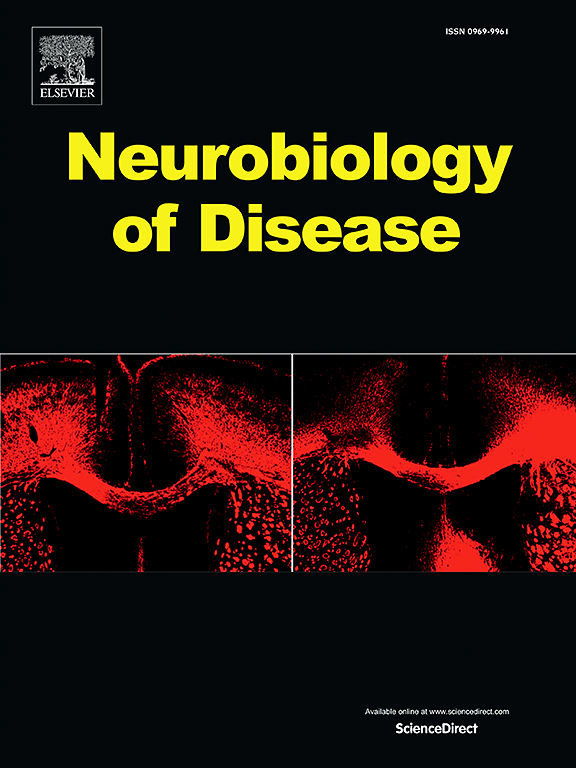Identification of presenilin mutations that have sufficient gamma-secretase proteolytic activity to mediate Notch signaling but disrupt organelle and neuronal health
IF 5.6
2区 医学
Q1 NEUROSCIENCES
引用次数: 0
Abstract
Mutations that cause familial Alzheimer's disease (AD) are predominantly found in the presenilin (PSEN) encoding genes PSEN1 and PSEN2. While the association of PSEN mutations with familial AD have been known for over 20 years, the mechanism underlying the impact these mutations have on disease is not fully understood. PSENs are phylogenetically conserved proteins that are found in diverse multicellular organisms ranging from plants to humans. PSENs form the proteolytic core of gamma-secretase that is required for cleaving type I transmembrane proteins, such as Notch receptors and the amyloid precursor protein. Importantly, familial AD-associated PSEN mutations are broadly distributed and do not clearly define a specific PSEN function essential for neuronal fitness. Here, using C. elegans as a model organism to study the in vivo functions of PSENs, we confirm that C. elegans PSEN plays a pivotal role in gamma-secretase proteolytic activity as well as maintaining neuronal and organelle health. Notably, we demonstrate that these two functions can be genetically uncoupled. Our research identifies several conserved familial AD-like missense mutations in the endogenous sel-12 gene, which encodes C. elegans PSEN. These mutations preserve sufficient gamma-secretase proteolytic activity to mediate Notch signaling but abolish PSEN's role in supporting neuronal and organelle health. Furthermore, we provide evidence that these familial AD-like missense mutations disrupt mitochondrial calcium regulation, ultimately leading to neuronal dysfunction. These results indicate that C. elegans PSEN plays at least two independent roles: one that mediates gamma-secretase proteolytic activity and another that mediates organelle and neuronal health.
早老素突变具有足够的γ -分泌酶蛋白水解活性,介导Notch信号,但破坏细胞器和神经元健康
导致家族性阿尔茨海默病(AD)的突变主要存在于早老素(PSEN)编码基因PSEN1和PSEN2中。虽然PSEN突变与家族性阿尔茨海默病的关联已被发现超过20年,但这些突变对疾病影响的潜在机制尚不完全清楚。PSENs是一种系统发育保守的蛋白质,存在于从植物到人类的多种多细胞生物中。PSENs形成γ -分泌酶的蛋白水解核心,这是切割I型跨膜蛋白(如Notch受体和淀粉样前体蛋白)所必需的。重要的是,家族性ad相关的PSEN突变分布广泛,并没有明确定义神经元适应性所必需的特定PSEN功能。本研究以秀丽隐杆线虫为模型生物研究PSENs在体内的功能,证实秀丽隐杆线虫的PSENs在γ -分泌酶蛋白水解活性以及维持神经元和细胞器健康中起关键作用。值得注意的是,我们证明了这两个功能可以在遗传上解耦。我们的研究在编码秀丽隐杆线虫PSEN的内源性self -12基因中发现了几个保守的家族性ad样错义突变。这些突变保留了足够的γ -分泌酶蛋白水解活性来介导Notch信号,但取消了PSEN在支持神经元和细胞器健康中的作用。此外,我们提供的证据表明,这些家族性ad样错义突变破坏线粒体钙调节,最终导致神经元功能障碍。这些结果表明秀丽隐杆线虫PSEN至少发挥两个独立的作用:一个介导γ分泌酶蛋白水解活性,另一个介导细胞器和神经元健康。
本文章由计算机程序翻译,如有差异,请以英文原文为准。
求助全文
约1分钟内获得全文
求助全文
来源期刊

Neurobiology of Disease
医学-神经科学
CiteScore
11.20
自引率
3.30%
发文量
270
审稿时长
76 days
期刊介绍:
Neurobiology of Disease is a major international journal at the interface between basic and clinical neuroscience. The journal provides a forum for the publication of top quality research papers on: molecular and cellular definitions of disease mechanisms, the neural systems and underpinning behavioral disorders, the genetics of inherited neurological and psychiatric diseases, nervous system aging, and findings relevant to the development of new therapies.
 求助内容:
求助内容: 应助结果提醒方式:
应助结果提醒方式:


